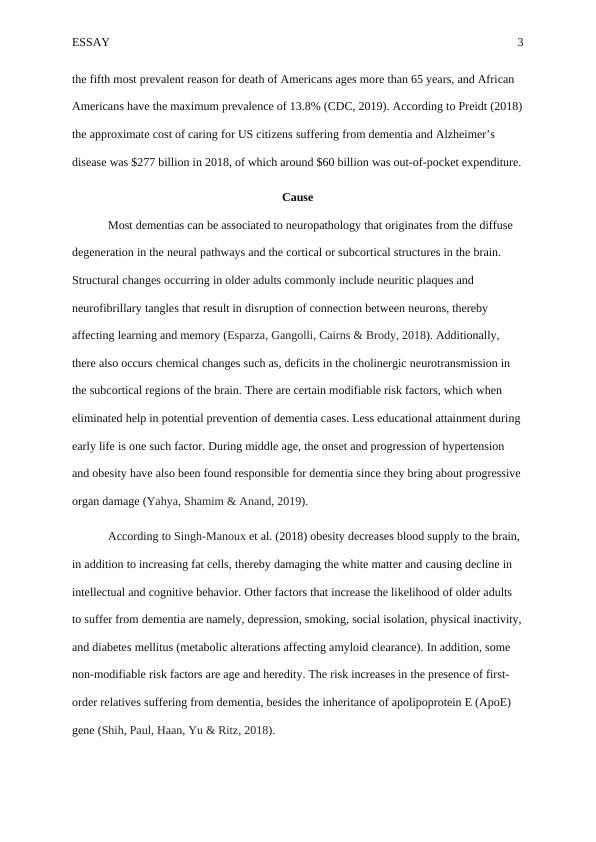Public Health Surveillance Results
Added on 2022-08-15
8 Pages1958 Words23 Views
Running head: ESSAY 1
Case study analysis
Name of the Student
Name of the University
Author Note
Case study analysis
Name of the Student
Name of the University
Author Note

ESSAY 2
Introduction
In recent times, public health surveillance has resulted in the recognition and
prioritization of a range of health problems that are prevalent in the world such as, diabetes
mellitus, HIV/AIDS, zoonotic diseases, waterborne diseases, antibiotic resistance, substance
abuse, and cardiovascular complications. The major objective of public health is to enhance
the quality of life of all people through proper prevention and treatment strategies, and is
generally accomplished through continuous monitoring of the health indicators and
promotion of healthy behavior (Brownson, Baker, Deshpande & Gillespie, 2017). This
assignment will elucidate on dementia that has been identified as a matter of major concern in
the United States.
Background
Dementia is an umbrella term that refers to brain disorders that bring about a decline
in the capability to remember and think, thereby gradually affecting the daily lives of the
patients. Researchers have recognized dementia as a global health priority owing to the fact
that the disease impedes neurotransmission in the brain, and no definite effective treatment
has been devised for curing this disease, though it is not a component of ageing (Livingston
et al., 2017). According to the World Health Organization (2019) around 50 million people
are affected with dementia, with an estimated 10 million new instances each year.
Alzheimer’s disease is the most prevalent type of dementia, affecting around 60-70% of the
total population.
The prevalence of this disease in the US can be accredited to the fact that
approximately 5.7 million affected individuals have been identified in the nation, with an
estimate that the total people affected with Alzheimer’s disease will increase to around 13.8
million by 2050 (ASHA, 2019). Moreover, Alzheimer’s disease has also been identified to be
Introduction
In recent times, public health surveillance has resulted in the recognition and
prioritization of a range of health problems that are prevalent in the world such as, diabetes
mellitus, HIV/AIDS, zoonotic diseases, waterborne diseases, antibiotic resistance, substance
abuse, and cardiovascular complications. The major objective of public health is to enhance
the quality of life of all people through proper prevention and treatment strategies, and is
generally accomplished through continuous monitoring of the health indicators and
promotion of healthy behavior (Brownson, Baker, Deshpande & Gillespie, 2017). This
assignment will elucidate on dementia that has been identified as a matter of major concern in
the United States.
Background
Dementia is an umbrella term that refers to brain disorders that bring about a decline
in the capability to remember and think, thereby gradually affecting the daily lives of the
patients. Researchers have recognized dementia as a global health priority owing to the fact
that the disease impedes neurotransmission in the brain, and no definite effective treatment
has been devised for curing this disease, though it is not a component of ageing (Livingston
et al., 2017). According to the World Health Organization (2019) around 50 million people
are affected with dementia, with an estimated 10 million new instances each year.
Alzheimer’s disease is the most prevalent type of dementia, affecting around 60-70% of the
total population.
The prevalence of this disease in the US can be accredited to the fact that
approximately 5.7 million affected individuals have been identified in the nation, with an
estimate that the total people affected with Alzheimer’s disease will increase to around 13.8
million by 2050 (ASHA, 2019). Moreover, Alzheimer’s disease has also been identified to be

ESSAY 3
the fifth most prevalent reason for death of Americans ages more than 65 years, and African
Americans have the maximum prevalence of 13.8% (CDC, 2019). According to Preidt (2018)
the approximate cost of caring for US citizens suffering from dementia and Alzheimer’s
disease was $277 billion in 2018, of which around $60 billion was out-of-pocket expenditure.
Cause
Most dementias can be associated to neuropathology that originates from the diffuse
degeneration in the neural pathways and the cortical or subcortical structures in the brain.
Structural changes occurring in older adults commonly include neuritic plaques and
neurofibrillary tangles that result in disruption of connection between neurons, thereby
affecting learning and memory (Esparza, Gangolli, Cairns & Brody, 2018). Additionally,
there also occurs chemical changes such as, deficits in the cholinergic neurotransmission in
the subcortical regions of the brain. There are certain modifiable risk factors, which when
eliminated help in potential prevention of dementia cases. Less educational attainment during
early life is one such factor. During middle age, the onset and progression of hypertension
and obesity have also been found responsible for dementia since they bring about progressive
organ damage (Yahya, Shamim & Anand, 2019).
According to Singh-Manoux et al. (2018) obesity decreases blood supply to the brain,
in addition to increasing fat cells, thereby damaging the white matter and causing decline in
intellectual and cognitive behavior. Other factors that increase the likelihood of older adults
to suffer from dementia are namely, depression, smoking, social isolation, physical inactivity,
and diabetes mellitus (metabolic alterations affecting amyloid clearance). In addition, some
non-modifiable risk factors are age and heredity. The risk increases in the presence of first-
order relatives suffering from dementia, besides the inheritance of apolipoprotein E (ApoE)
gene (Shih, Paul, Haan, Yu & Ritz, 2018).
the fifth most prevalent reason for death of Americans ages more than 65 years, and African
Americans have the maximum prevalence of 13.8% (CDC, 2019). According to Preidt (2018)
the approximate cost of caring for US citizens suffering from dementia and Alzheimer’s
disease was $277 billion in 2018, of which around $60 billion was out-of-pocket expenditure.
Cause
Most dementias can be associated to neuropathology that originates from the diffuse
degeneration in the neural pathways and the cortical or subcortical structures in the brain.
Structural changes occurring in older adults commonly include neuritic plaques and
neurofibrillary tangles that result in disruption of connection between neurons, thereby
affecting learning and memory (Esparza, Gangolli, Cairns & Brody, 2018). Additionally,
there also occurs chemical changes such as, deficits in the cholinergic neurotransmission in
the subcortical regions of the brain. There are certain modifiable risk factors, which when
eliminated help in potential prevention of dementia cases. Less educational attainment during
early life is one such factor. During middle age, the onset and progression of hypertension
and obesity have also been found responsible for dementia since they bring about progressive
organ damage (Yahya, Shamim & Anand, 2019).
According to Singh-Manoux et al. (2018) obesity decreases blood supply to the brain,
in addition to increasing fat cells, thereby damaging the white matter and causing decline in
intellectual and cognitive behavior. Other factors that increase the likelihood of older adults
to suffer from dementia are namely, depression, smoking, social isolation, physical inactivity,
and diabetes mellitus (metabolic alterations affecting amyloid clearance). In addition, some
non-modifiable risk factors are age and heredity. The risk increases in the presence of first-
order relatives suffering from dementia, besides the inheritance of apolipoprotein E (ApoE)
gene (Shih, Paul, Haan, Yu & Ritz, 2018).

End of preview
Want to access all the pages? Upload your documents or become a member.
Related Documents
Alzheimer’s Disease: Effects on the Human Brainlg...
|1
|808
|327
Developing the Research Question Assignment 2022lg...
|6
|1434
|9
PUBLIC HEALTH. PUBLIC HEALTH. 1. 1. : PUBLIC HEALTH. PUlg...
|3
|494
|53
Nursing Essay in Dementia: Evidence Based Practice and Caregiver Managementlg...
|8
|2518
|346
Impact of Pharmacotherapy in the Management of Alzheimer in NZ - Reportlg...
|7
|2549
|80
Australia Battling with Alzheimerlg...
|20
|4472
|294
